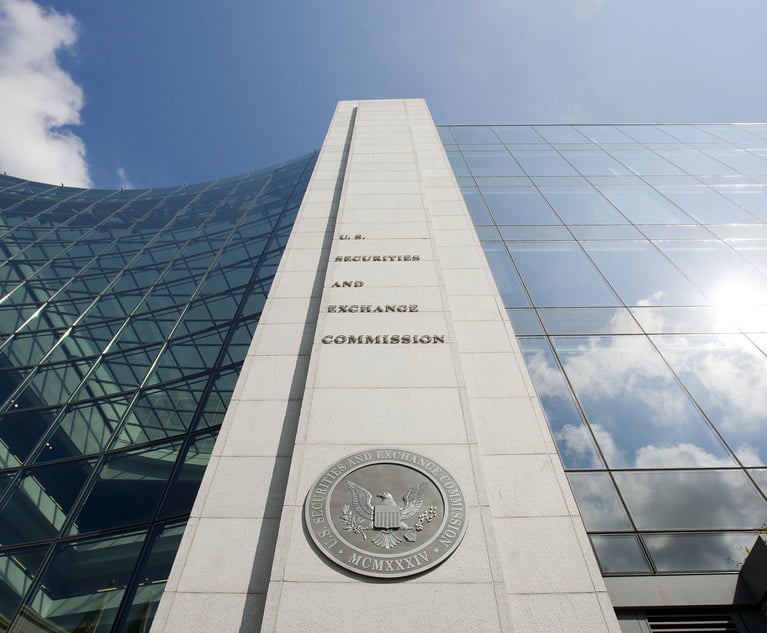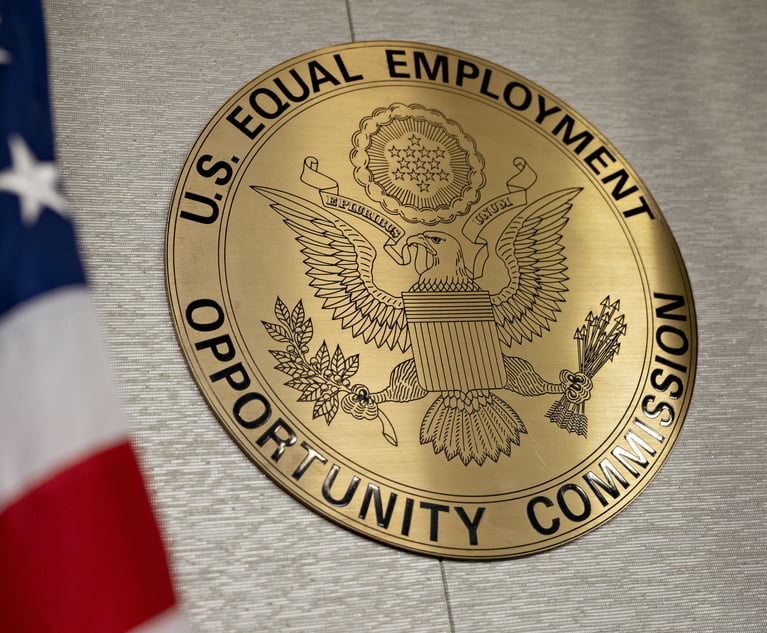Alien Allegations
Jury clears Chevron of responsibility in Nigerian security operation.
February 28, 2009 at 07:00 PM
6 minute read
It has been a decade since 100 members of the Ilaje tribe in Nigeria took over an offshore oil facility owned by a subsidiary of Chevron Corp. Why these people decided to occupy the platform, located nine miles off the Nigerian coast, is a highly contentious issue. What is not in dispute is that at the end of the three-day occupation, Nigerian government security forces, called in at the request of Chevron's subsidiary, shot four of the tribesmen, killing two of them.
Backed by several human rights groups, the surviving Illaje filed suit against Chevron in 1999, alleging the parent company was responsible for the deaths under the Alien Tort Statute (ATS), a law dating back to 1789 that has developed over time to allow foreign plaintiffs to bring suit in the U.S. for violations of the law of nations. The claim was based on the allegation that Chevron aided and abetted the Nigerian forces by paying them for security services. The plaintiffs characterized the occupants as peaceful protesters, while Chevron claimed they were hijackers who took over the platform and held the workers hostage.
The case survived summary judgment and proceeded to trial. On Dec. 1, 2008, a jury decided in favor of Chevron.
The case is unique in that it is one of only a handful of lawsuits invoking the ATS against a company to make it to trial. Moreover, it is the first such case to test whether a corporation can be held responsible for the actions of government security forces it calls upon for protection.
“The court found that the military can be Chevron's agent when carrying out activities, if those activities were resonably related to the kind of tasks Chevron asked them to do, in this case security,” says Paul Enzinna, a partner at Baker Botts. The jury, however, found that the force used by the military was reasonable given the evidence presented in court.
Tort History
The ATS has taken a winding journey over the last 200 years. For centuries, the act remained out of the limelight, gaining prominence in 1980 when it was used against a state actor in Fil?rtiga v. Pe?a-Irala, a suit filed against a Paraguayan police official for the torturing and killing of a Paraguayan man. The act was expanded in the early 1990s when it was used against a non-state actor in Kadic v. Karadzic.
The statute was first wielded against a corporation in 1997, when a group of Myanmar villagers used it to sue Unocal Corp. for commissioning Myanmar soldiers who allegedly practiced forced labor. Before that case could proceed to a verdict, Unocal settled.
In 2004 the U.S. Supreme Court further defined the statute, ruling that the act itself does not provide its own right of action, but rather provides jurisdiction for violations of the law of nations. Such a violation is an act universally recognized as wrong, such as murder or slave trading.
“For plaintiffs to be successful in an Alien Tort Statute claim, they have to show a nexus between what the corporation did and the abuse itself,” says Tyler Giannini, clinical director of Harvard Law School's Human Rights Program. He formerly served as co-director of EarthRights International, co-counsel for the plaintiffs in the Chevron case and co-counsel in the landmark Unocal litigation. Recently, human rights organizations are filing more ATS suits, which the courts are allowing to go to trial with greater frequency.
“The U.S. courts are more willing to hear cases against corporations for complicity, and this sends a signal that these certain practices are egregious enough to warrant action in court,” Giannini says.
Chevron admitted to retaining Nigerian security forces and calling them to the scene to assist with the Ilaje occupiers. However, its legal staff took great pains to document the actions of the occupiers and to gather evidence to secure its defense that they had planned a hijacking with the intention of extorting money and benefits from Chevron. In addition, Chevron argued the plaintiffs' injuries and the deaths occurred as Nigerian security forces carried out authorized law enforcement responsibilities.
“I think the result [of the trial] certainly suggests that our view of the evidence was more credible than the plaintiffs',” says Charles James, vice president and general counsel of Chevron.
In the Pipeline
Despite Chevron's victory, Bowoto v. Chevron is not over. The organizations representing the plaintiffs have vowed to file an appeal.
But in cases against corporations concerning human rights abuses, a win in court isn't always the overriding motive. Sometimes the public relations fallout from the case is enough for the plaintiffs to claim victory, even when the defense wins. Enzinna says this was the situation in an ATS case he successfully defended for Drummond Company Inc., involving the assassination of union leaders by Colombian paramilitaries.
“In the Drummond case, the plaintiffs said they didn't want to see it go to trial because they liked seeing it in the newspapers, and that served the purpose almost as well as getting a verdict,” Enzinna says.
As Chevron assesses what, if any, blemishes the Bowoto case made to its corporate reputation, other lawsuits dealing with the ATS are continuing to appear on the courts' dockets. For example, the mining company Rio Tinto is accused of human rights and environmental abuses in Papua New Guinea. In December 2008, the 9th Circuit sent the case back to the district court, giving the presiding judge the discretion to require the plaintiffs to show that all local legal remedies have been exhausted before their ATS case can proceed (see this story).
But the most anticipated of the pending cases is against Royal Dutch Shell. The plaintiffs allege the energy company was complicit in a string of human rights abuses that also occurred in Nigeria. The case survived summary judgment and has moved on to the trial stage.
“This is the next key case to watch,” Giannini says. “This is all part of a pattern that illustrates there are more and more of these cases going to trial or being settled.”
This content has been archived. It is available through our partners, LexisNexis® and Bloomberg Law.
To view this content, please continue to their sites.
Not a Lexis Subscriber?
Subscribe Now
Not a Bloomberg Law Subscriber?
Subscribe Now
NOT FOR REPRINT
© 2025 ALM Global, LLC, All Rights Reserved. Request academic re-use from www.copyright.com. All other uses, submit a request to [email protected]. For more information visit Asset & Logo Licensing.
You Might Like
View All

Trending Stories
- 1Uber Files RICO Suit Against Plaintiff-Side Firms Alleging Fraudulent Injury Claims
- 2The Law Firm Disrupted: Scrutinizing the Elephant More Than the Mouse
- 3Inherent Diminished Value Damages Unavailable to 3rd-Party Claimants, Court Says
- 4Pa. Defense Firm Sued by Client Over Ex-Eagles Player's $43.5M Med Mal Win
- 5Losses Mount at Morris Manning, but Departing Ex-Chair Stays Bullish About His Old Firm's Future
Who Got The Work
J. Brugh Lower of Gibbons has entered an appearance for industrial equipment supplier Devco Corporation in a pending trademark infringement lawsuit. The suit, accusing the defendant of selling knock-off Graco products, was filed Dec. 18 in New Jersey District Court by Rivkin Radler on behalf of Graco Inc. and Graco Minnesota. The case, assigned to U.S. District Judge Zahid N. Quraishi, is 3:24-cv-11294, Graco Inc. et al v. Devco Corporation.
Who Got The Work
Rebecca Maller-Stein and Kent A. Yalowitz of Arnold & Porter Kaye Scholer have entered their appearances for Hanaco Venture Capital and its executives, Lior Prosor and David Frankel, in a pending securities lawsuit. The action, filed on Dec. 24 in New York Southern District Court by Zell, Aron & Co. on behalf of Goldeneye Advisors, accuses the defendants of negligently and fraudulently managing the plaintiff's $1 million investment. The case, assigned to U.S. District Judge Vernon S. Broderick, is 1:24-cv-09918, Goldeneye Advisors, LLC v. Hanaco Venture Capital, Ltd. et al.
Who Got The Work
Attorneys from A&O Shearman has stepped in as defense counsel for Toronto-Dominion Bank and other defendants in a pending securities class action. The suit, filed Dec. 11 in New York Southern District Court by Bleichmar Fonti & Auld, accuses the defendants of concealing the bank's 'pervasive' deficiencies in regards to its compliance with the Bank Secrecy Act and the quality of its anti-money laundering controls. The case, assigned to U.S. District Judge Arun Subramanian, is 1:24-cv-09445, Gonzalez v. The Toronto-Dominion Bank et al.
Who Got The Work
Crown Castle International, a Pennsylvania company providing shared communications infrastructure, has turned to Luke D. Wolf of Gordon Rees Scully Mansukhani to fend off a pending breach-of-contract lawsuit. The court action, filed Nov. 25 in Michigan Eastern District Court by Hooper Hathaway PC on behalf of The Town Residences LLC, accuses Crown Castle of failing to transfer approximately $30,000 in utility payments from T-Mobile in breach of a roof-top lease and assignment agreement. The case, assigned to U.S. District Judge Susan K. Declercq, is 2:24-cv-13131, The Town Residences LLC v. T-Mobile US, Inc. et al.
Who Got The Work
Wilfred P. Coronato and Daniel M. Schwartz of McCarter & English have stepped in as defense counsel to Electrolux Home Products Inc. in a pending product liability lawsuit. The court action, filed Nov. 26 in New York Eastern District Court by Poulos Lopiccolo PC and Nagel Rice LLP on behalf of David Stern, alleges that the defendant's refrigerators’ drawers and shelving repeatedly break and fall apart within months after purchase. The case, assigned to U.S. District Judge Joan M. Azrack, is 2:24-cv-08204, Stern v. Electrolux Home Products, Inc.
Featured Firms
Law Offices of Gary Martin Hays & Associates, P.C.
(470) 294-1674
Law Offices of Mark E. Salomone
(857) 444-6468
Smith & Hassler
(713) 739-1250







